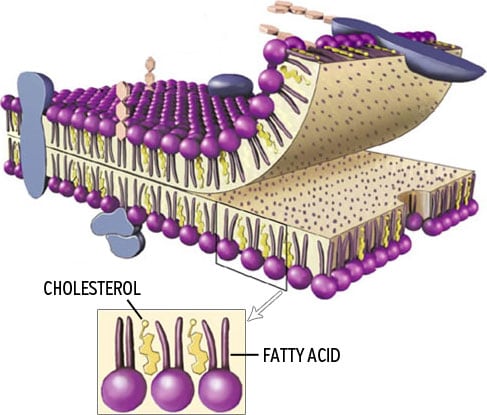The membrane that surrounds every nerve cell is the “site of action” for many of the brain’s essential functions. Both layers of the membrane are made from fatty acids. The fatty acids in your diet determine the types of fatty acids that end up in your cell membranes.
The composition of the cell membrane determines how well you can think, learn, remember and how resistant your brain is to stress, injury or diseases like epilepsy, Parkinson’s or Alzheimer’s.
Ideally the membrane should be in the form of a flexible gel which maintains cell structure while allowing membrane contents to move.
Alcohol consumption creates excessive membrane fluidity while cholesterol, and saturated and monounsaturated fats can greatly reduce the fluidity of the membrane leaving it stiffened and dysfunctional.
Over time, poor diet and stress increase the membrane’s cholesterol while decreasing its fatty acid content. This reduces membrane fluidity and results in depression, memory loss, learning difficulties, poor eyesight, poor temperature regulation and a lowered pain threshold.
Scientists from around the world have shown that consuming essential fatty acids in the correct ratio can restore membrane fluidity and reverse the aforementioned dysfunctions.
Decades of investigation into the role of fatty acids in brain development, degeneration and restoration give evidence that eating the right fats in the right ratio can result in healthier babies with an enhanced lifelong learning ability, reduced incidence of memory loss in the elderly and cases of epilepsy and protection from brain-damaging synthetic chemicals and radiation.
The two most prominent brain cell fatty acids are DHA, which the body makes from alpha linolenic acid or stearidonic acid, and AA (arachidonic acid) which it body makes from linoleic acid.

Commercial interests have filled mainstream media with the view that omega 3 is a “hero” while omega 6 is a “villain”. Yet what science has revealed is that both are essential, though it is the form and ratio between the omega 6 and 3 you eat that determines if your membranes end up with enough DHA and AA .
Thought it might seem that people already consume ample omega 6, most of the linoleic acid in modern diets is oxidised trans fat which can't be used to make healthy nerve cell membranes.
Arbuckle et al compared the DHA level in the nerve cell membranes of newborns fed two different omega-3 formulas. The alpha linolenic acid formula increased membrane DHA levels. Those fed fish oil increased DHA in the blood but decreased DHA in membranes of both brain and eye cells.
Furthermore, Carlson et al showed that dietary DHA supplementation causes a reduction of AA levels in the blood and when given to infants for the first 19 months of life, those fed fish oil suffered stunted growth and retardation of brain development compared those who were not fed fish oil.
When testing different dietary fatty acid compositions on Alzheimers patients the results were that neither whole fish oil or isolated DHA produced any benefit; however linoleic acid and alpha linolenic acid in a ratio of 4:1 significantly improved brain function and quality of life.
Fatty acid formulas with an omega-6:3 ratio of 4:1have been shown to be most efficient at both lowering cholesterol levels and raising DHA levels in nerve cell membranes.
Wainright compared five different ratios of Omega 6:3, with 4:1producing the healthiest babies. Rappaport measured daily consumption of AA and DHA in brain cell membranes at 17.8mg and 4.6mg respectively a ratio of 3.8:1.
Yehuda tested seven different ratios of dietary omega 6:3 on learning, memory, pain threshold, sleep and temperature regulation. The 3.5:1and 4:1 ratios produced the best results in every test.
Other than EPA and DHA, which are non-essential and are found in fish, hemp seed oil contains the right fatsin the right formin the highest amount of any known food.
It is also the only oil with the right ratioof Omega 6:3, which is naturally between 3.5:1 and 4:1, and contains cholesterol-lowering, stroke-preventing phytosterols, along with palmitic acid, which increases the amount of omega 6 penetrating the brain, and stearodonic acid,which does the same with omega 3.
Unlike rapidly oxidising fish or flax, hemp oil tastes good and is naturally protected from oxidation by antioxidant carotenes, xanthophylls and vitamin E. Also unlike fish oil, hemp seed oil is free from heavy metalslike mercury.
- Soapbox is a regular column in which industry figures comment on a product, service, policy or study of their choosing. All views are the author's own and do not necessarily reflect those of FoodNavigator-Asia.
